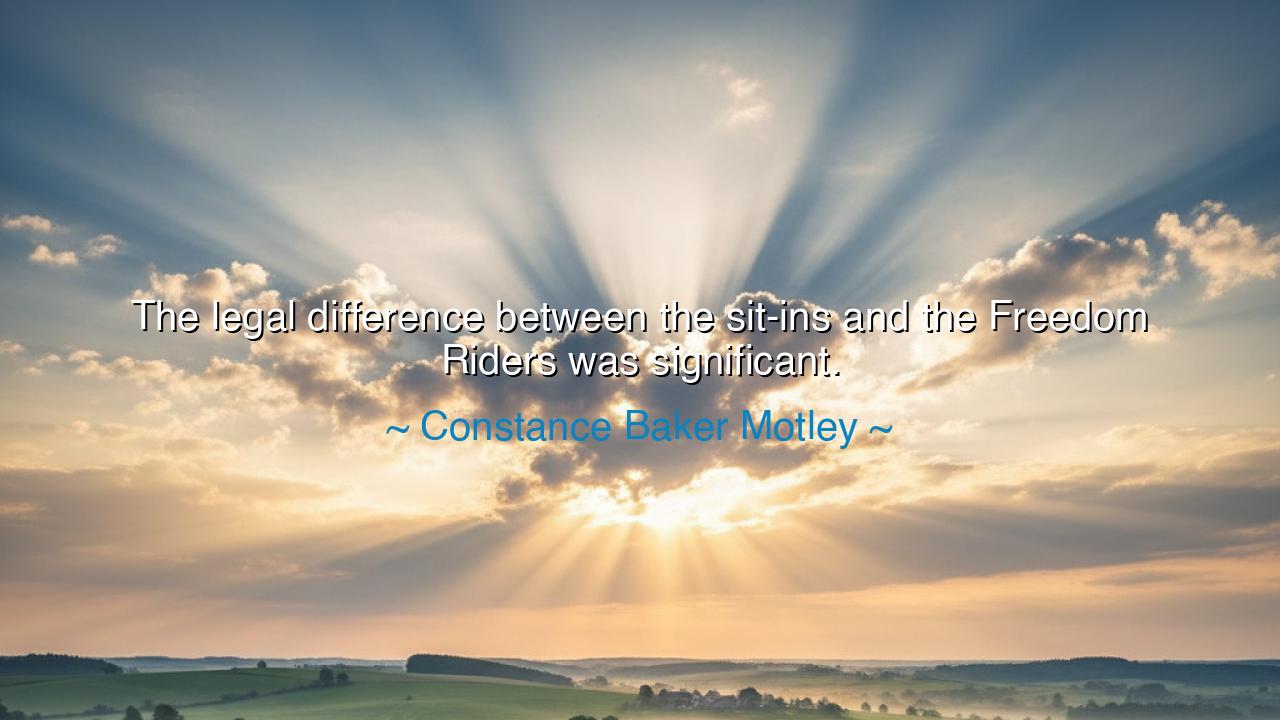
The legal difference between the sit-ins and the Freedom Riders






When Constance Baker Motley stated, “The legal difference between the sit-ins and the Freedom Riders was significant,” she spoke not merely as a lawyer recounting history, but as a witness to a great spiritual battle fought in the courts and on the streets of America. In her words lies a subtle yet profound truth: that justice, though universal in spirit, often moves through the narrow channels of law, and that within those channels, small distinctions can shape the fate of a movement. Motley, one of the towering figures of the Civil Rights era, understood that the struggle for freedom was not only waged in protest and song, but also in the meticulous crafting of legal arguments — the invisible warfare of principle and precedent.
The sit-ins, where Black students peacefully occupied segregated lunch counters, and the Freedom Rides, where activists challenged segregation on interstate buses, were both acts of courage. Yet their legal standing differed. The sit-ins targeted private establishments within states — restaurants, diners, and department stores — bound by state laws that sanctioned racial separation. The Freedom Riders, by contrast, confronted federal law: they rode buses across state lines to test Supreme Court rulings that had already declared segregation in interstate travel unconstitutional. In other words, the sit-ins defied unjust laws that still existed, while the Freedom Riders exposed the nation’s failure to enforce the just laws already won. That, Motley said, was the “significant difference.”
To understand the weight of her words, we must remember the time in which she spoke. America in the 1960s was a land torn between its ideals and its realities. Constance Baker Motley herself had helped craft many of the legal victories that laid the foundation for civil rights — she was the first Black woman to argue before the Supreme Court, and she fought in cases that desegregated schools and universities across the South. Yet she knew that law alone could not cleanse the conscience of a nation. It could only draw the lines upon which brave souls would stand, and sometimes fall, to make the spirit of justice visible in flesh and blood.
The sit-ins began with young students in Greensboro, North Carolina, in 1960. They sat at a Woolworth’s lunch counter, calm and composed, while insults and threats swirled around them. They broke no law of violence, but they defied a code of hate. Their protest was moral disobedience, meant to awaken a nation’s heart. The Freedom Riders, on the other hand, took their stand on moving ground. They boarded buses in 1961, traveling from Washington, D.C., into the deep South, knowing that mobs awaited them. Their purpose was to test whether the federal government would uphold its own rulings. When their buses were burned in Alabama, when blood spilled on southern roads, it revealed to the world the gulf between legal victory and lived equality.
Motley’s insight reveals the dual nature of justice: the legal difference between these two acts may have been technical, but the moral unity was eternal. Both the sit-ins and the Freedom Rides were expressions of a deeper law — one written not by courts, but by conscience. Yet as a jurist, Motley understood that moral clarity must find legal expression if it is to endure. The movement needed both the fire of the protester and the pen of the lawyer, for passion without structure can burn out, while structure without passion becomes lifeless. She stood as the bridge between those worlds — between the street and the Supreme Court, between the dream and its definition.
Her words also carry a lesson for every generation that seeks change. True progress is not only about courage in the moment, but about understanding the systems that shape the world. Revolution without knowledge risks collapse, while knowledge without conviction achieves nothing. The young who sat at counters and rode buses needed the wisdom of those like Motley to translate their bravery into lasting reform. Likewise, today’s seekers of justice must learn not only to march, but to argue, to legislate, to build the new law upon the ashes of the old.
So remember, as Constance Baker Motley taught through both her voice and her life: there is no freedom without understanding the ground upon which it stands. The legal difference she spoke of was more than a footnote in history — it was a reminder that every act of liberation must find its foundation in both heart and reason. The world changes not only through defiance, but through definition. Let your passion burn, but let it be guided by knowledge. For in the union of those two — the courage of the protester and the clarity of the jurist — the eternal flame of justice is kept alive.






AAdministratorAdministrator
Welcome, honored guests. Please leave a comment, we will respond soon